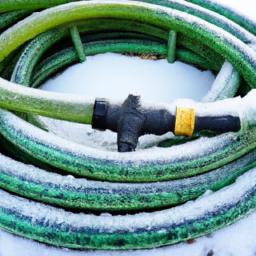How To Keep Garden Hose From Freezing
Table of Contents []
How To Keep Garden Hose From Freezing
Introduction
Dealing with a frozen garden hose during winter might be a headache for many. In this article, we will look at how you can keep your garden hose from freezing as a preventative measure. Knowing the right steps and taking prompt action can help you avoid any unintentional damage due to frost. We will explore in detail about eight pertinent topics that will help you get your garden hose ready to face subzero temperatures. The topics we will cover are (1) Drain the Garden Hose, (2) Use an Heater Cable, (3) Manual Hose Wrap, (4) Insulated Hose Sleeve, (5) Use Heated Water for Washing, (6) Consider Other Outdoor Supplies, (7) Opt for Frost-resistant Hoses, and (8) Store the Hose Away during Winter.
1. Drain the Garden Hose
The foremost and essential step is to make sure you drain the garden hose completely. Water collecting inside the hose, when frozen and expanded, can cause the internal walls to burst. So, flush out the water and close all the faucets tightly. Any water left inside the hose can be emptied out by unknotting the hose and slightly tipping it. Furthermore, using a vacuum can help to exhaust out all the remaining moisture.
2. Use an Heater Cable
Setting up an electric heater cable is another reliable method of keeping the garden hose from freezing. Heater cables are usually extremely long which in turn makes them a viable option for keeping most lengths of garden hose frost-free. Ensure to follow all the instructions supplied while setting up the cable, to prevent any mishaps. Furthermore, make sure to wrap the cable in a spiral manner along the length of the hose to enhance its effectiveness.
3. Manual Hose Wrap
For those situations when you do not have the availability of an electric heater, manual wrapping is the most convenient option. Wrapping the hose in a spiral pattern with a insulation material such as an old blanket, bubble wrap, or foam wrap is highly preferred. Pre-made insulating covers that are specifically made for garden hoses can also be used as an alternate. Just make sure to secure the wrap fast and cover the entire length of the hose.
4. Insulated Hose Sleeve
Similar to manual wrapping, insulated hose sleeves are also a viable option. These specially designed hose sleeves come pre-fitted with insulating material such as fiberglass, aluminum, or insulation foam. All you need to do is to slide the hose sleeve on the entire length of the garden hose and secure it using the attached straps. Make sure no air gaps are left between the hose and the protective cover before snugly looping it up.
5. Use Heated Water for Washing
If you have a short garden hose or for any reason you're using coldwater for washing, it is best to opt for heated water instead to prevent the water from freezing inside the hose. It is easy to prepare the heated water using warmers or any other affordable sources easily available near you.
6. Consider Other Outdoor Supplies
Apart from your garden hose, it is equally important to consider other outdoor supplies that are susceptible to freezing during winter season. The list of potential items can range from a bird bath, garden pond, spigot, garden faucet, etc. Make sure you deep-clean and dry them before totally wrapping them up for extreme weather.
7. Opt for Frost-resistant Hoses
Safety wise, it's advised to use frost-resistant hoses or hoses with heat-trapping capability when dealing with freezing winter temperatures. This is because regular hoses are extremely susceptible to low temperatures and can easily be damaged or lead to major leaks. Hence, take a look at specialized frost-resistant hoses that are made from durable material such as rubber, or vinyl with heat-trapping ability.
8. Store the Hose Away during Winter
On the flip side, you can also opt to store away the hose in a dry place during wintertime. This ensures that the hose and all its parts remain in secure and safe condition all throughout the winter season. Make sure to complete all the steps we discussed above before storing away the hose.
Conclusion
In conclusion, taking the appropriate steps for protecting your garden hose from freezing and other winter-related damages is the key to ensuring long-term efforts. Following the steps mentioned above will help ensure that your garden hose stays safe and remains operational despite the cold winter temperature. Keep in mind that these measures are both cost-effective and safe, so you can use them without worries.

Previous Page
